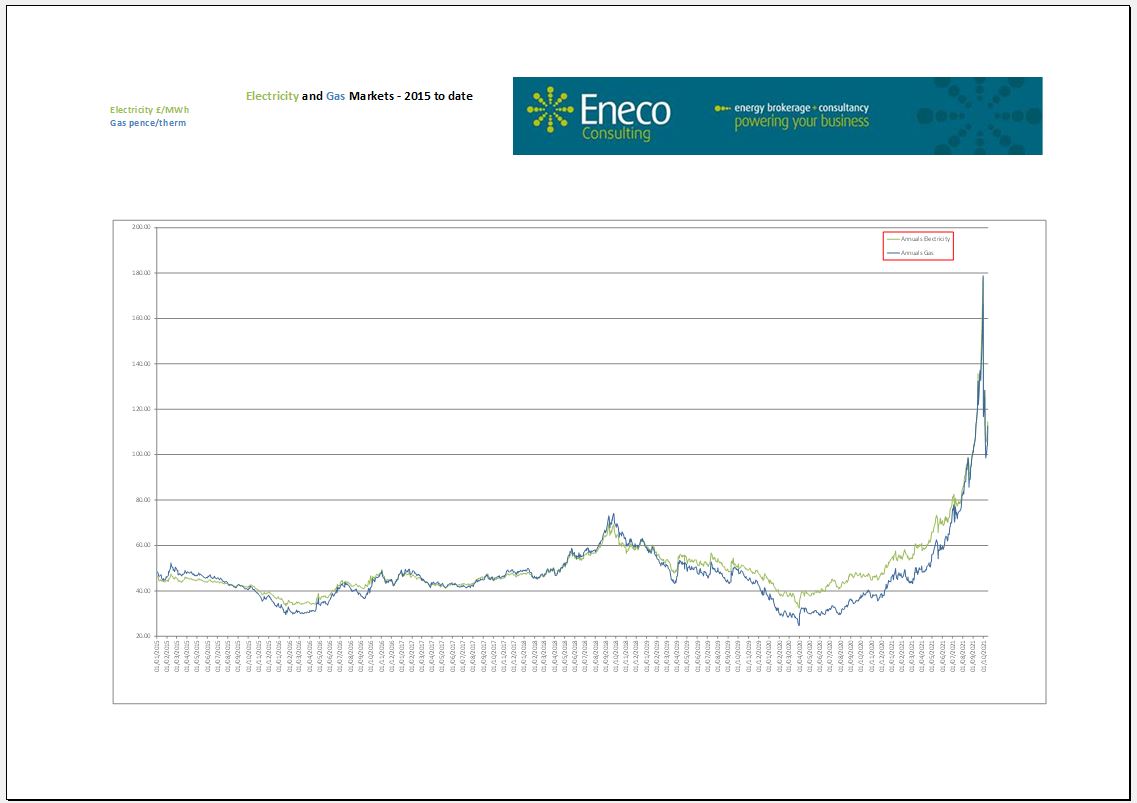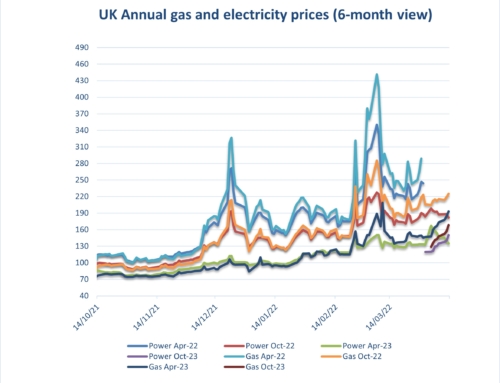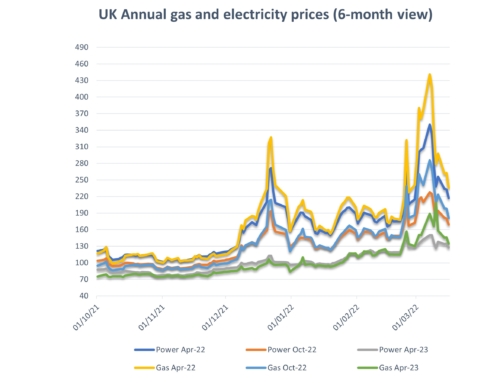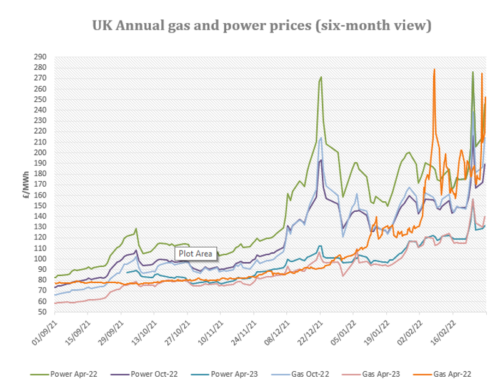Eneco market reports mid October 2021
Energy costs:
Gas and energy prices continue to be extremely unpredictable. Month ahead energy prices have reached astonishing highs of as much as £360/MWh whilst Gas prices even exceeded 400 p/therm for a day. This did settle briefly following intervention from Putin, however, over the last few days prices have started to ratchet higher again across all markets – power, gas, coal, emissions – amid lingering underlying supply nerves and no evidence that Russian gas supplies will actually increase in the wake of Putin’s comments. Coal prices have been lifted too by a sharp increase in Chinese imports as flooding has knocked out some domestic mines there and a fire at a Russian export terminal.
While Putin’s gas tease has been one major factor driving volatility, other factors have also been at play, including weather forecast changes, exchanges increasing collateral requirements (forcing some traders to close positions), LNG market price swings and profit-taking. Stop-loss buy and sell levels being triggered and low market liquidity have further exacerbated the price movement.
Unplanned outages in the North Sea continue to impact on prices; however, operators have also postponed some planned but non-essential maintenance in the face of the current gas squeeze, while LNG imports into northwest Europe have continued to improve.
North Sea oil prices, currently at $84/barrel are being driven up as demand increases due to generators switching from oil-fired to gas-fired generation whilst it is more economical to do so.
Factors supporting Increases:
Supply outages –Norwegian and North Sea unplanned production outages continue with flows significantly reduced.
Gas storage – European storage is at 78%, compared to 95% this time last year. Concerns over storage levels in the light of a potentially cold start to winter continue to drive current market increases.
Carbon – EUETS emissions reached EURO 63/TC02 due to the continued use of coal and gas for electricity generation.
Coal – Prices have reached $132/tonne as supply issues persist around the globe and demand for coal fired generation increases particularly in Asia.
Factors supporting decreases:
Norway-UK interconnector – test flows are continuing to arrive across the interconnector. Full commissioning is expected imminently.
LNG –Asian LNG prices have fallen sharply particularly for Summer 22 (27% down) and some shipments are heading towards Europe albeit still in low numbers.
Weather/Wind – Low pressure weather systems are expected into the UK next week bringing increased wind speeds and less reliance on gas for power production. We may finally have an opportunity to test our threefold increase in wind capacity.
Could go either way:
Sterling – has weakened slightly against the Dollar but remains largely stable against the Euro. However, this should be monitored as this can amplify increases on the wider energy markets onto UK gas and electricity markets.
Oil markets – Oil is currently trading around $84/barrel, with real increases being kept in check by OPEC’s planned production increases. However, experts are still expecting an increase in demand over Winter adding further pressure on prices.
Non-energy costs:
On the electricity side organisations will see further increases in pass through costs from both government and industry infrastructure providers from 2022 onwards due to pandemic-related demand destruction. Levies normally collected via unit rates have fallen short of expectations and have fed through to further increases in ROs, FiTs, EII and other transportation, distribution and renewable investment charges. In addition to this the Targeted Charging Review (TCR) is coming into effect from April 2022 and is being priced into renewal contracts now. Projections are available on our website via the links below.
What is the Targeted Charging Review (TCR) electricity –
TCR is a change to both Distribution Use of System (DUoS) and Transmission Network Use of System (TNUoS) charges you will find within a supply contract.
DUoS: changes in effect from 01/04/2022 (delayed from 2021)
- Paid to the associated distributor (DNO), the cost covers installation and maintenance of local distribution networks.
- At present, a DUoS charge is based on the volume of electricity consumed at site, which has passed through the distribution network.
TNUoS: changes in effect from 01/04/2023 (delayed from 2022)
- Paid to National Grid, the cost recovers the cost of installing and maintaining transmissions systems.
- At present, the charge is based on a meter’s share of demand on the network during 3 peak periods, known as Triads. These 3 Triad periods occur between 1st Nov to 28th Feb each year. It’s assessed during this time as demand on the grid is at its highest.
Why the change? A lot of businesses have Triad avoidance techniques in place. During November to February, the 3 largest consuming days will affect a TNUoS charge for a whole year, therefore it pays to be savvy in cutting down consumption on days which would otherwise have been large consuming. Ofgem want to eradicate an unfair grid, therefore both DUoS and TNUoS charges will be veering away from a consumption-based charge to a daily-based charge, determined by voltage type (where you connect to the network), measurement class (Half-Hourly/Non-Half-Hourly), and maximum agreed capacity.
It’s a complex change and difficult to assess the impact on individual meters as suppliers are allocating charges differently. although many are wrapping TCR into increased standing charges. However, to summarise, meters with high capacity but lower usage will be worst affected. For example, a sports stadium will have a high agreed capacity to account for large peaks on event/match days, yet for the most part will have a relatively small usage compared to this capacity. If you want to discuss this further, please call into the office to speak with Abby.
Is your organisation covered by the new Streamlined Energy and Carbon Reporting (SECR) scheme from the Environment Agency?
Designed to replace in part the Carbon Reduction Commitment (CRC) which ended in 2019 and to follow on from the energy savings recommendations generated by ESOS compliance. Note, SECR will cover a wider scope of organisations than CRC and ESOS do. SECR requires all large enterprises to disclose within their annual financial filing obligations to Companies House, their greenhouse gas emissions, energy usage (from gas, electricity and transportation as a minimum), energy efficiency actions and progress against at least one intensity ratio.
If your organisation qualifies, participation in this scheme is mandatory. Eneco Consulting are happy to provide assistance with your regulatory obligations. Full details are available on our website on the link below.
Are you eligible for an EII rebate?
Under current rules, if you qualify at an industry sector level and your business passes the 20% electricity intensity test you may qualify for exemption to CFD and RO charges. Please see the attached Government RO/CFD guidance document and update and give Abby a call on the main number to discuss this further.
Eneco market information mid October 2021
Gas and electricity prices from 2009 to date
A copy of our environmental charges and Climate Change Levy rates from 2012 to date: Industry and Environmental Pass Through Charges including CCL p/kWh Updated 31082021
A copy of RO/CFD guidance document: RO_CFD_Guidance_Revised_July_2018
SECR: SECR EA Guidelines
TCR Charges (Targeted Charging Review this will be revised in November 2021 when Ofgem releases its review): TCR Charges (Targeted Charging Review) TNUOS bandings and Current Ofgem Costs now for 2023 onwards




